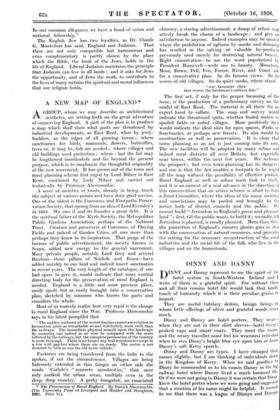A NEW MAP OF ENGLAND *
AGROUP, whom we may describe as architectural aesthetes, are setting forth on the great adventure of conserving England. A part of the plan is to produce a map which shall show what parts are threatened by industrial developments, as East Kent, what by jerry- builders, as the edges of all growing towns ; where sanctuaries for birds, mammals, flowers, butterflies, trees or, it may be, fish are needed ; where villages and old buildings need protection ; where—but the list may be lengthened inordinately and far beyond the present purpose, which is to emphasize the thoughtful originality Of the new movement. It has grown out of the town and rural planning scheme first urged by Lord Milner in East Kent, continued by Lady Milner and carried out technically by Professor Abercrombie.
A score of societies or trusts, already in being, touch the subject at various points and have done good service. One of the oldest is the .Commons and Footpaths Preser- vation Society, that sprang from an idea of Lord Eversley's in i864. We owe it and its founder a great debt. It is the spiritual father of the Kyrie Society, the Metropolitan Public Gardens Association, perhaps of the National Trust. Creators and preservers of Commons, of Playing Fields and indeed of Garden Cities, all owe more than perhaps they know to its inspiration. That purge of the horrors of public advertisement, the society known as Scapa, added new energy to the general movement. Many private people, notably Lord Grey and several Buxtons—those pillars of Norfolk and Essex—have added notably to our bird and indeed insect sanctuaries in recent years. The very length of the catalogue, if one had space to give it, would indicate that some central directing body for the preservation of rural England is needed. England is a little and most precious place, easily spoilt but as easily brought into a conservation plan, sketched by someone who knows the parts and considers the whole.
Most of us scarcely realize how very rapid is the change in rural England since the War. Professor Abercrombie says in his latest pamphlet that "The sudden outburst of the motor-bus has caused a revolution in locomotion quite as remarkable as and indefinitely more swift than the railways. The immediate physical assault upon the landscape by motoring can indeed in no wise be compared with the scars inflicted by the railways, but the complete permeation of the country is more thorough. There is no longer any real remoteness except in a few wild patches where there are no roads. The motor is not daunted by hills as was the old horse vehicle."
Factories are being transferred from the hubs to the spokes, if not the circumference. Villages are being hideously extended in thin fringes on either side the roads. Carlyle's " concrete mendacities," that once only marked the urban areas, multiply even in the deep, deep country. A perky bungalow, an emaciated * The Preservation of Rural England. By Patrick Abercrombie. (The University Press of Liverpool and Hodder and Stoughton,
MI. Price is.) • - -
chimney, a staring advertisement, a dump of refuse may utterly break the charm of a landscape ; and give no satisfaction to anyone. Indeed examples may be quoted where the prohibition of ugliness by smoke and dumping has resulted in the salving of valuable by-products previously used merely for destroying natural beauty. Right conservation—to use the word popularized by President Roosevelt—weds use to beauty. Mountain, Moor, Down, Fell, Fen, Forest, River, and Coast ask for a conservative plan. So do famous views. So do scores of old villages. So do quiet nooks, where stand
" our favourite elms that screen the herdsman's solitary hut."
The first act, if only for the proper focussing of the issue, is the production of a preliminary survey on the model of East Kent. The material is all there for an expert hand to collate. The map and survey would indicate the threatened spots, whether fouled waters or spoiled fields or soiled villages. More positively they would indicate the ideal sites for open spaces, Parks or Sanctuaries, or perhaps new forests. Its aim would be construction as well as preservation. It is clear that town planning as an art is just coming into its own. The new facilities will be adopted lay many urban and indeed rural districts all over Britain, but especially near towns, within the next few years. We welcome the . prospect ; but even town-planning has its dangers ; and one is that the Act enables a footpath to be wiped off the map without the possibility of effective protest. Rural- England as well as urban must look to itself; and it is an earnest of a real advance in the direction of this conservation that an active scheme is afoot to form a Joint Committee, where the ideas of the many societies and associations may be pooled and brought to the notice both of district councils and the public. We cannot build " Jerusalem in England's green and pleasant land "; first, till the public wants to build it; secondly, till Jerusalem is planned, is rurally planned. More than this: the protection of England's country glories goes in stew with the conservation of natural resources, and provides the setting for the necessary reconstruction of the rural industries and the social life of the folk who live in the villages and on the homesteads.






















































 Previous page
Previous page